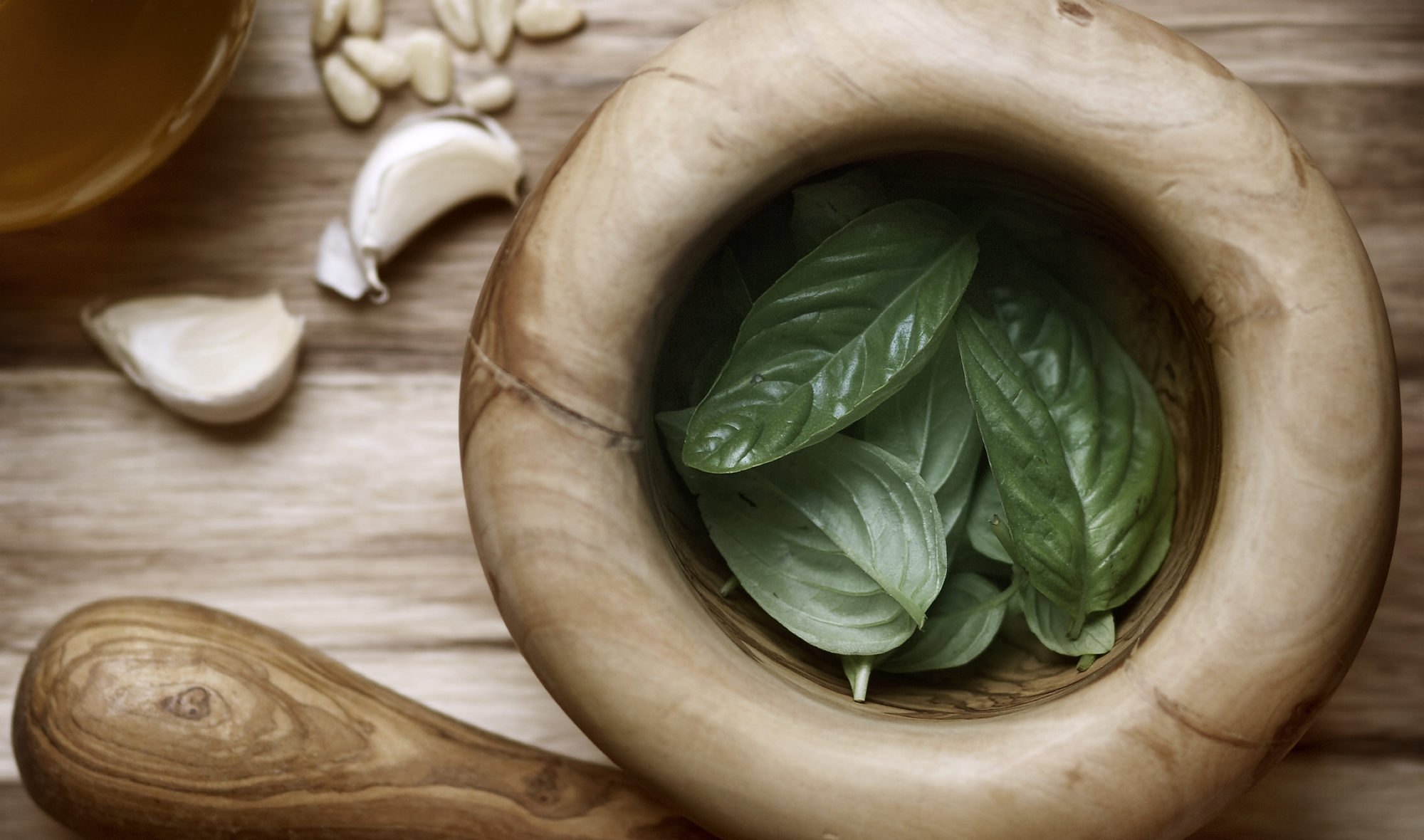
Join PN Level 2 for less than $9 USD/day! Affordable monthly payments now open.

Basil is a bright green herb with a sweet-savory taste known for its use in Italian cooking. Seasonal during summertime, basil grows in big, leafy bunches. It’s not only packed with flavor, basil also offers loads of potassium, as well as Vitamin A, folate, and iron. Add basil leaves to salads or sandwiches, or blitz basil into pesto sauce, which makes a great condiment for grilled meats.
Basil is an herb that belongs to the mint family. In Western cooking (particularly Italian cuisine), the most common variety is sweet basil, also known as Genovese basil. It has a sweet-savory flavor with hints of licorice and mint.
Thai basil, lemon basil, and holy basil are other varieties of the same family, which are more common in Asia.
Like many herbs, basil can be found dried or fresh. This entry concentrates on fresh sweet basil.
Basil is a bright green plant, with large pointed leaves and thin stalks. It grows in big, leafy bunches.
A quarter cup of fresh basil has 1.0 calories, 0.19g of protein, 0.04g of fat, 0.16g of carbohydrates, 0.1g of fiber, and 0.02g of sugar.
Basil is an excellent source of potassium (18 mg in a 1/4 cup). It’s also a good source of manganese, copper, vitamin A, folate, and iron.
Basil is seasonal in summertime but it can usually be purchased year-round. You may find it in packages or bundled loose in the produce section of your grocery store.
Choose bright green, fragrant leaves with no signs of wilting or blackening.
For the freshest basil, try growing it yourself! Starter plants may be available at your local nursery or grocery store during the spring and summer months.
Basil is best eaten as soon as possible after picking.
If you’re going to eat the basil within a couple days, you can keep it on your kitchen countertop in a glass or pitcher of water, as you would fresh cut flowers. Change the water daily, and keep the basil out of direct sunlight.
If keeping the basil for longer you can store it in the fridge, in a loose, open plastic bag or the container you purchased it in.
Wash basil well in cool water. (If the basil is very dirty, place it in a large bowl and cover it with cool water. Swish the basil around to release the dirt. Pull the basil out of the water, rinse the bowl, and repeat until all the dirt and grit is gone.)
Pinch the basil leaves off of the stems. You can then tear the basil with your hands or slice it thinly with your knife.
If you’re slicing the basil, try this trick: stack a bunch of leaves onto each other, and roll them up with your fingers to create a tight tube. Then cut across the leaves horizontally with your knife to create thin slivers. This is known as a chiffonade and is excellent as a garnish.
Take note that basil can bruise easily and turn black. To avoid this, tear gently with your fingers or slice carefully with a sharp knife.
Basil is best eaten fresh. In cooking, basil will wilt and lose its best flavor, so add it at the end of recipes when possible.
One of the most popular preparations of basil is pesto: an Italian sauce / condiment made of fresh basil, pine nuts, parmesan cheese, and olive oil.

Perfect for a quick weeknight pasta, this traditional pesto recipe will be a sure hit with your friends and family. Pair it with a green salad and a big side of veggies for a flavourful and nutritious meal.
Prep Time: 10 minutes Cook Time: 0 minutes Yield: 4 servings
In a blender, combine oil, garlic, salt, and pine nuts. Blend until combined. Add the basil in batches, pulsing and stopping every few moments to scrape the sides with a spatula.
Transfer into a bowl. Fold in the cheese until combined.
Store in an airtight container for up to 4 days.
Makes enough Pesto to dress 1 pound (1 package) pasta.
Enjoy!
Precision Nutrition’s Encyclopedia of Food expands every single month as we highlight new foods and showcase beautiful food photography. If you’d like to stay up to date, simply click this link. From there, we’ll send you a FREE copy of our recipe book. We’ll also let you know when new and delicious foods are added to the site.
Basil is a bright green herb with a sweet-savory taste known for its use in Italian cooking. Seasonal during summertime, basil grows in big, leafy bunches. It’s not only packed with flavor, basil also offers loads of potassium, as well as Vitamin A, folate, and iron. Add basil leaves to salads or sandwiches, or blitz basil into pesto sauce, which makes a great condiment for grilled meats.